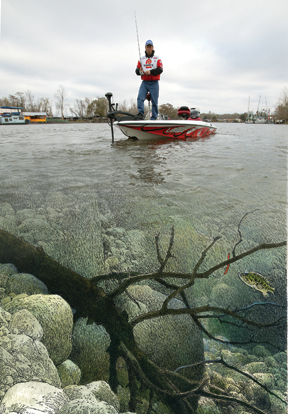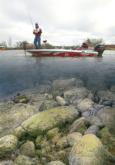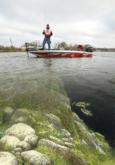Excess finesse
More competitive anglers add soft-plastic finesse approaches to their game plans

Big baits catch big bass. The old adage that larger-profile lures tempt larger bass still holds true, but in modern-day tournament fishing, big bass do not always win tournaments. Sometimes the big bass fail to make themselves available, or conditions call for more subtle presentations. Finicky bass coupled with increased fishing pressure on many impoundments calls for more finesse on the angler’s part.
Manufacturers took notice of the growing trend in finesse fishing, with about every soft-plastics maker forging downsized versions of their most popular offerings. Even with all of the new lures to select from, Lawry’s pro Jim Moynagh of Carver, Minn., likes to keep his bait selection simple.
“It depends on where I am and what the fish are doing, but a 5-inch worm on a 1/8-ounce jighead is hard to beat,” Moynagh said.
As for color selection, he likes to keep that simple, too.
“I tend to go with darker tones like June bug, green pumpkin or watermelon when fishing tight to the bottom,” he said. “If I’m doing more of a swimming retrieve, then I’m usually in clear water to begin with, so I’ll use a watermelon-colored bait or a bait with some sort of shad color in it.”
While finesse fishing with soft plastics is not new in competitive circles, more and more anglers are finding that these micro baits and rigs offer another way to catch bass when the pressure mounts. Fishing pressure, weather and time all weigh heavily on an angler’s ability to produce bass in the clutch. Even when deciding to scale down, anglers still have to decide which method will work best. For simplicity, let’s take three common finesse rigs – the split-shot rig, the drop-shot rig and the jighead worm – and look at them more closely.
The split-shot rig
The split-shot rig basically consists of a small 1/0 hook with a small piece of split shot pinched to the line about 18 to 24 inches up from the hook. It presents a bait like a 4-inch worm with a small, seductive fall while still being castable. Ideally, the bait settles better and casts more efficiently on line in the 4- to 8-pound-test range.
More of an open-water rig, it excels at covering vertical structures such as steeply sloping banks, docks and bluff walls from a distance. It also works surprisingly well in timber. While the weight isn’t generally heavy enough to pull it down over branches, its light weight allows for the bait to rest on limbs and then fall off into open water where bass suspend. The split-shot rig is also effective around floating boat docks, where fish often suspend.
There is really no wrong way to work the bait as long as you do it slowly. In fact, one great technique for suspended fish is to vertically fish them with a do-nothing split-shot rig. Basically, once you have located fish on the fish finder, you get on top of them and cast the bait out from the boat at approximately the number of feet the fish are suspended under the boat. Then just let the bait swing back under the boat. Once it is directly underneath the boat, just hold the rod perfectly still. Suspended fish, especially spotted bass, will ease up to the bait, and you will feel either a slight tick on your line or you will actually see the line go slack or load up. All you have to do is make a nice, easy sweep upward and keep pressure on the fish.
Split-shot rigs can also be fished much like a Carolina rig; however, its light weight gives it a totally different action. While you are not necessarily trying to feel the bottom, you are creating the illusion of something swimming along the bottom. You want to keep the bait moving on semitight line. Try to avoid keeping the line too tight because you will take away some of the natural action of the rig.
Drop-shotting exploded onto the bass-tournament scene several years ago, and the technique shows no signs of fading as a proven method for catching bass. Even though anglers consider drop-shotting a finesse technique, it often produces heavyweight bass. Fish lurking on the bottom or suspended in timber fall for the rig just the same. The key to the presentation lies in an angler’s ability to leave the bait in the strike zone but continue to dance it like a live creature.
Again, light line is a mainstay for drop-shotting, but in dingier water, anglers find that heavier line and bait-casting equipment produces well. Generally the rig starts with a small hook tied to the line with a tag end of about 18 to 24 inches left to secure a small but heavy weight.
Drop-shotting started as a way to cover lots of deep water by stair-stepping down ledges and fishing in and around deep cover. But it also produces well in shallower situations and will work on suspended bass. Regardless of where you fish it, the presentation relies on just moving the rod tip enough to feel the weight at the end of the line but not move it. Every time you pull your line tight, the bait will undulate on the hook, and gingerly shaking the bait tempts wary bass into biting more often than not.
The jighead worm
The late, great Hoot Gibson of Wal-Mart FLW Tour co-angler fame said he could take a 4-inch worm threaded on a small 1/8-ounce jighead and catch bass anywhere in America. He proved that fact on numerous occasions, and many other anglers took notice. While many anglers have been fishing tubes and grubs on jigheads, fishing a small worm on a jighead still takes a backseat to other, more popular methods like Texas-rigging and Carolina-rigging.
 Moynagh used a jighead worm to take home $39,000 and a fourth-place finish in the 2003 Wal-Mart Open on Beaver Lake. “When I’m on a lake that I feel has a good population of spotted bass and smallmouths and the water is clear, then that’s when I like to fish a worm on a jighead,” Moynagh said. “You’re just as apt to catch a big fish on these baits as you are a small one.”
Moynagh used a jighead worm to take home $39,000 and a fourth-place finish in the 2003 Wal-Mart Open on Beaver Lake. “When I’m on a lake that I feel has a good population of spotted bass and smallmouths and the water is clear, then that’s when I like to fish a worm on a jighead,” Moynagh said. “You’re just as apt to catch a big fish on these baits as you are a small one.”
The jighead worm may be the most versatile soft-plastic finesse setup. Common techniques for the jighead worm include hopping along the bottom, dragging and swimming. An underused yet extremely productive method is shaking. Simply cast the bait, let it fall to the bottom, shake with quick twitches of the rod, wait a moment, shake it again, then hop it a few feet and start the shaking process all over again.
Moynagh likes to fish the bait on sandy or gravel bottoms or around big rocks. It also works great for bedding fish. The jighead worm has a much different profile than a tube or grub, and oftentimes that profile change will trigger bedding fish into striking when other techniques have failed.
Concentrating on the mood of the fish and keeping an open mind to finesse approaches will put more bass in the livewell. Sometimes, one extra fish spells the difference between going all the way and coming up a little short, and sometimes the only way to boat a bass is to finesse them, so be armed with some subtleness.
Finessing them with bulk?
Moynagh offers some tips for fishing bulky Senko-type baits (such as a Kinami Flash or Tiki Stick), which most consider a finesse approach.
“Fishing a Senko is usually a slow way to fish one small spot,” said Moynagh, who usually limits his Senko fishing to the spawning period. “I want the fish to be up on the beds or up in spawning areas when I use this bait because fish in that stage are usually reluctant to chase a spinnerbait or crankbait.”
Moynagh casts his soft-plastic stick bait to where he thinks or knows the bed will be. Then he continually feeds line until the bait meanders down to the bottom. Once it gets there, he will give the bait a slight twitch and let it sit motionless for a moment. The twitch will often draw a strike from an active bass, and if not, the bait lying motionless before and after the twitch presents an opportunity too tantalizing or too irritating for a bass to ignore. If nothing takes the bait, Moynagh then reels the bait closer to the boat and starts the process again. Sometimes one cast can take several minutes, but if he believes there are bass from the bank to his boat, he tries to maximize the time and scour the area as methodically as possible.
Senko-type baits are often rigged with no weight, which allows the bait to fall slowly with a natural appearance. When vegetation is thick, however, or when the wind is too stiff, a small weight allows the bait to get to the bottom without being blown off course.
